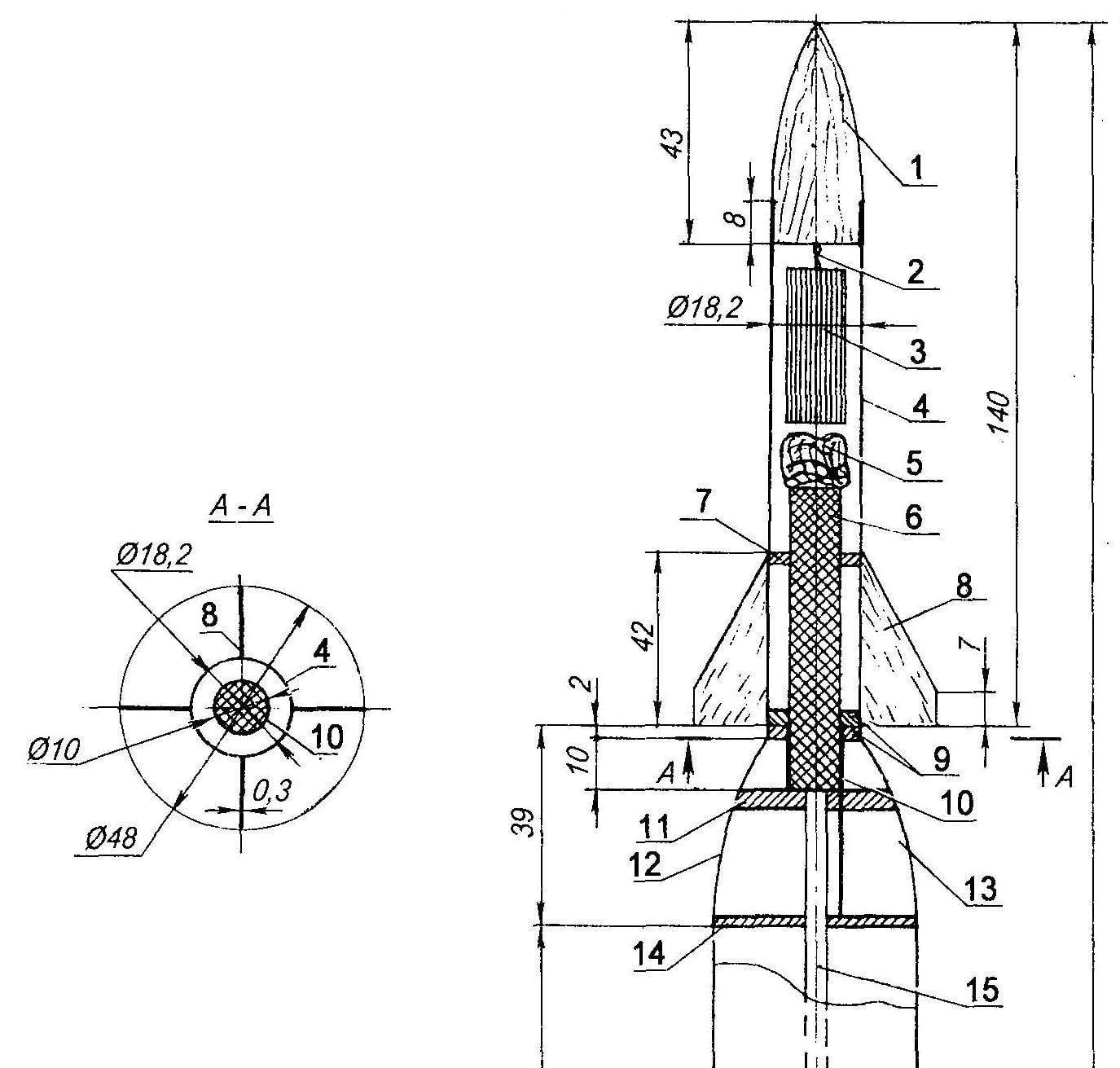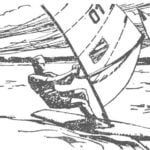 All conscious life Vladimir Menshikov associated with the sky. In his childhood he built flying model airplanes. Hence the choice of a profession. And as a matter of course, flying school. The profession of pilot in the way to heaven is opened. More than 20 years, the cockpit of a helicopter—his main place of work, and the wheel—tool. But don’t forget Vladimir and the children’s hobby is modeling. Designed model, but now missiles. What I remember Volodya (as our longtime friendship can call it so), it has always featured the true, the desire to make new, more interesting than others. So, in 1982, he first adapted for remote control launch model rockets fragment of the control stick helicopter (its upper part).
All conscious life Vladimir Menshikov associated with the sky. In his childhood he built flying model airplanes. Hence the choice of a profession. And as a matter of course, flying school. The profession of pilot in the way to heaven is opened. More than 20 years, the cockpit of a helicopter—his main place of work, and the wheel—tool. But don’t forget Vladimir and the children’s hobby is modeling. Designed model, but now missiles. What I remember Volodya (as our longtime friendship can call it so), it has always featured the true, the desire to make new, more interesting than others. So, in 1982, he first adapted for remote control launch model rockets fragment of the control stick helicopter (its upper part).
He worked for many years as a pilot in Siberia and sweltering Africa. Flew a lot of flight time at the controls of the helicopter, returning home on leave, found satisfaction in the construction of models of missiles in creative, this process. He’s one of the first developers of a new category of sports models of rotochutes.
For many years V. Menshikov always “spelled out” in the team “rocket” at first the USSR, then—Russia. Today Vladimir is an honored master of sports, repeated world champion, the deserved trainer of Russia.
Otletov its in the sky, after retiring from the flight work, he devoted himself to his childhood passion. Organized sports-technical club in the city of Uray, Tyumen region, actively working with youth, setting an example of true service to heaven. Among his pupils many have linked his life to aviation, rocketry—K. Vlasov, I. Proskuryakov, etc.
Of the eight championship categories rocket models almost all (except for S8—redirectable) subject to the Vladimir Menshikov. In many categories was a multiple champion of Russia, prize-winner and winner of the Championships of Europe and world. But especially impressive are the achievements of Vladimir in the category of high-rise models—S1. In 1998 in Romania, he became a double world champion. Before that, in 1996, he was first in the category of S4—models raketoplana.
A landslide victory in the 16th world championship at Baikonur was won by V. Menshikov is in a class of models for the altitude. His model— “skyscraper” class Ѕ1В rose to 612 m.
I must admit that this design is an example of the creative cooperation of two world Champions, honored masters of sports, Russian rocketmodeler Oleg Voronov and Vladimir Menshikov.
I believe that sports the “shell” the world champion is of interest to those who aspire to winning heights.

A model rocket class S1B world champion Vladimir Menshikov:
1 —fairing; 2 — FAL; 3—a brake band of the second stage; 4—the case of the second stage; 5 — wad; 6 — MRD the second step; 7 — frame; 8 — stabilizer is a second stage; 9 — power frames; 10 — connecting bushing boarding steps; 11 —a support frame; 12 — parabolic part of the body of the first stage (upper fairing); 13—compartment, placing the recovery system of the first stage; 14 — frame; 15—tube-ognevoj; 16—the case of the first stage; 17— base frame; 18—stabilizer of the first stage; 19—frames and engine mounts; 20—mrad first stage
The first stage is made of two layers of glass, of a thickness of 0.03 mm on the mandrel with a diameter of 39.9 mm. In the lower part (tapered) glued three balsa bulkhead in the bottom two drilled holes with a diameter of 10.2 mm, and the third reference — with a diameter of 4 mm. the Reference frame is limiting the possible longitudinal displacement of MRD at the start is because his starting momentum is large enough. In the hole reference frame glued to the lower end of the tube-ognevaya length of 330 mm.
Top case (upper fairing)—parabolic shape. Its length is 39 mm. It is also a molded fiberglass on a separate mandrel.
After the facing (circumcision its length), it is fixed three frames with the holes in the two bottom—4 mm in diameter in the military (landing)-10,3 mm. Then, in the fairing, make two longitudinal incision and cut out the leaf maximum width of 20 mm (not shown) that closes the compartment further embed recovery system stage. Then on top of the fairing glued to a fiberglass tube with a length of 12 mm, which is the landing for the second stage engine when connecting both stages in the Assembly of the entire model. Fixed fairing on the upper end of the tube-ognevaya, spitted on her holes in the frames and gluing with epoxy. To the tube-Ognevoy tie the umbilical cord (strong string), which, in turn, attach the flap and the brake band of the first stage. At the start, fold the top fairing (in closed position) is fixed by the retaining cotter—pin from wire with a diameter of 0.5 mm and glued to a force frame of the second stage.
Stabilizers (3) of the first stage are cut from the balsa plate thickness 0,6—0,7 mm. Their lateral surfaces are reinforced with fiberglass with resin and attached to the conical part of the housing at the butt with epoxy resin.
The housing of the second stage as well as the first, made of fiberglass with a binder on the mandrel with a diameter of 17.9 mm. After hardening of the resin the resulting workpiece is clamped in the Chuck of the lathe and on small speed (about 300-400 rpm) process an emery paper and coated with parquet lacquer. Then butt the size (length 105 mm) sharpened cutter. Bottom two glued inside the frame from balsa wood, 3 mm thick, pre-drilled holes in them with a diameter of 10.2 mm mrad. Inside the upper part of the body secure the halyard to its connection with the head fairing and the brake band (recovery system). For a good monitoring level and adjust the height of the flight of the brake band is made with a length of 3 — 3.5 m.
The stabilizers of the second stage (four of them) are formed from three layers of carbon fiber, reaching thicknesses of 0.25—0.3 mm. attaches them butt to the rear of the housing at the location of the frames.
Fairing machined from Linden, well-treated and coated with two layers of varnish, then polished. At the bottom edge of the skirt is glued loop fastener of the tether.
Starts “skyscraper” by V. Menshikov on two engines designed by I. Taborskeho pulse at 5 n. MRD of the first stage decelerator has a deceleration of the second engine is about 6.5—7 S.
Flight weight of the model without engine is about 30 g.
Preparing to launch high-rise model is a quite responsible task. So focus on it in detail. The sequence of preparation steps is not important. Will start after all the bottom. As mentioned above, MRD without retarder tightly inserted into the holes of the frames until it stops at the end of the support frame, pre-poured into a tube ognevoj one scoop of powder. In the practice of rocketmodeler for a bushel take a shorter sleeve (length 4 mm) from the cartridge small-bore rifle.
Then in the upper compartment of the fairing puts the recovery system of the first stage (the brake band); close the compartment flap, hold it in this position a strip of tape. Previously inside the brake band should be podprugin a piece of foam.
The second stage engine is also tightly inserted into the holes of the frames, leaving a loose skirt with a length of 12 mm. Then the top of the engine case, put a wad of paper, fill it with talcum powder, paint (to create a colored cloud in the disclosure of the rescue system) and put the brake band.
Then combine the steps by inserting the skirt MRD the second step in the mounting (connection) of the first sleeve, wherein the locking check (pin) of the second stage captures from the opening on the side of the fairing of the first stage. A strip of tape then it is necessary not to forget to remove. Before this you need to fill in the nozzle of the upper MRD 4-5 “grains of powder”. Connection steps—due to the tight fit of the skirt MRD the second step in the splice sleeve of the fairing. The alignment holes of the tube-ognevaya and engine nozzle laid constructively.
Starts the model with a gasdynamic installation of a “cap”. At a height of 15— 20 m there is an operation you ribnogo charge MRD first stage, a firing pulse is transmitted through the tube and ignites the MRD the second step. That rapidly goes up. Check the snap releases the flap, and it is under the action of the spring properties of the compressed foam flies from the body, pulling the brake band of the first stage.



